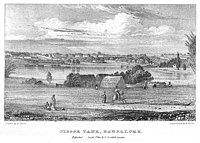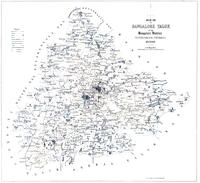
Bruhat Bengaluru Mahanagara Palike (BBMP) is the administrative body responsible for civic amenities and some infrastructural assets of the Greater Bengaluru metropolitan area. It is the fourth largest Municipal Corporation in India and is responsible for a population of 8.4 million in an area of 741 km2. Its boundaries have expanded more than 10 times over the last six decades.

Vibuthipura Lake is a lake in the suburb of Hindustan Aeronautics Limited, in the southeast of the city of Bengaluru. The lake is the part of Bellandur-Varthur Lake series.
Puttenahalli WS Lake also spelled as Puttanahalli Lake is a 10-hectare water body near Yelahanka, 14 km north of Bangalore.

Madiwala lake is one of the biggest lakes in Bangalore, India spread over an area of 114.3 hectare. The water in the lake was fit for drinking till the early 1990s. Since then it has become unfit for drinking due to industrial waste and sewage entering the waterbody. It has gradually become polluted.
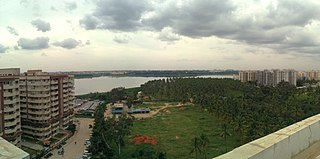
Bellandur Lake is located in the suburb of Bellandur in the southeast of the city of Bengaluru. It is the largest lake in the city. It is a part of Bellandur drainage system that drains the southern and the south-eastern parts of the city. The lake is a receptor from three chains of lakes upstream, and has a catchment area of about 148 square kilometres. Water from this lake flows further east to the Varthur Lake, from where it flows down the plateau and eventually into the Pinakani river basin.

Agara lake is an 80-acre lake located in Agara, Bangalore. It is part of the Varthur lake series. Madiwala Lake is upstream while Bellandur Lake is downstream. Inter-lake connections have seen fragmentation and urbanisation.
Yelahanka Lake is a water body near Yelahanka, a suburb of Bangalore.

Bellandur is a suburb in south-east Bangalore, Karnataka, India. It is bounded by HSR Layout to the west, Devarabisanahalli to the east, Sarjapur Road to the south, and the Bellandur Lake to the north. The Bellandur Lake is the largest lake in Bangalore, and separates Bellandur from the HAL Airport. The Outer Ring Road passes through Bellandur, making the area an important transit point between east and south Bangalore.
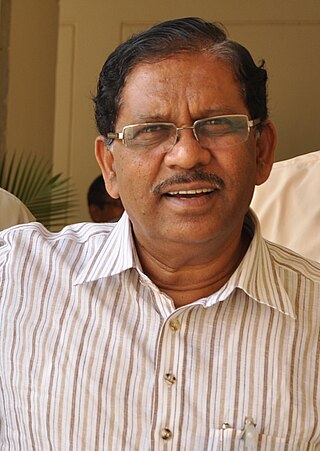
GangadharaiahParameshwara is an Indian politician who is currently serving as the Home Minister of Karnataka since 27 May 2023. He has also served as the seventh Deputy Chief Minister of Karnataka, and longest-serving President of the Karnataka Pradesh Congress Committee for two consecutive terms.
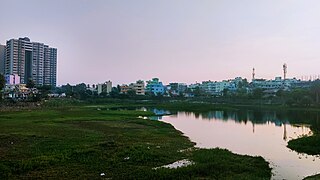
Puttenahalli lake is a small, restored freshwater lake located in JP Nagar 7th Phase, South Bangalore. The area of the lake is about 13 acres. The primary water sources are rain and surface water diverted to the lake through channels. The lake is currently maintained by Puttenahalli Neighbourhood Lake Improvement Trust (PNLIT) . The lake was on the brink of extinction, but due to the efforts of PNLIT, is now a haven for bird-watchers and on its way to being completely restored.

Bengaluru, formerly called Bangalore in English, is the capital and largest city of the southern Indian state of Karnataka. It has a population of more than 8 million and a metropolitan population of around 15 million, making it India's third most populous city and fourth most populous urban agglomeration. It is the most populous city and largest urban agglomeration in South India, and is the 27th largest city in the world. Located on the Deccan Plateau, at a height of over 900 m (3,000 ft) above sea level, Bengaluru has a pleasant climate throughout the year, with its parks and green spaces earning it the reputation of India's "Garden City". Its elevation is the highest of India's major cities.

The Thurahalli Forest or Thurahalli Park is a dry and deciduous forest. It is located about 20 km from Bengaluru off Kanakapura Road. It is 13 km from Banashankari and can be overseen from the NICE road. Entry inside the park has been banned for vehicles, however, it has become a hot spot for cyclists.

D. Kupendra Reddy an Indian politician, entrepreneur and a social worker. He is a former Member of Parliament in the Rajya Sabha, the upper house of the Parliament of India from 2014 to 2020. He is representing Karnataka from Janata Dal (Secular) party, a regional political party headed by H D Deve Gowda, former Prime Minister of India..
The Lake Development Authority (LDA) in Bangalore, Karnataka, and its successor the Karnataka Lake Conservation and Development Authority (KCLDA) were formed in 2002 and 2015 respectively. Karnataka Tank Conservation and Development Authority (KTCDA) under the Minor Irrigation Department became the superseding agency.
Jaraganahalli Lake was a lake in the southern part of Bengaluru, India.
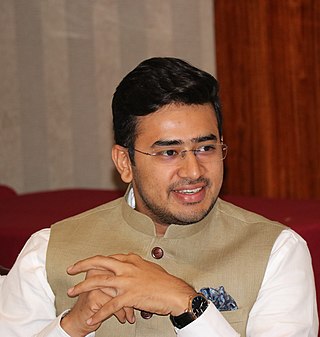
Lakya SuryanarayanaTejasvi Surya is an Indian politician, RSS swayamsevak and lawyer serving as the Member of Parliament in the 17th Lok Sabha from the Bharatiya Janata Party, representing the Bangalore South constituency. He is also the president of the Bharatiya Janata Yuva Morcha since 26 September 2020.
Garakamanthana Palya or G. M. Palya is one of the neighbourhoods in Bengaluru. It is part of C. V. Raman Nagar Assembly constituency in East Bengaluru. It is named after Garakamantha. Kaggadasapura, Vignananagar, Basavanagar, Malleshpalya, BEML, LBS Nagar, Shivananda Nagar, Puttappa Layout, Byrasandra, Cauveri Colony, Krishnappa Gardeen, C. V. Raman Nagar, Vimanapura are the nearby localities.

The 2015 Bruhat Bengaluru Mahanagara Palike election was held on 22 April 2015 in all 198 Wards of Bangalore (Bengaluru).

The 2024 Bruhat Bengaluru Mahanagara Palike elections are to be held after the Indian general election in May 2024 to elect corporators for all 243 wards of the Bruhat Bengaluru Mahanagara Palike. The elections, due in 2020, have been delayed due to factors such as the COVID-19 pandemic, process of ward delimitation and lack of consensus over reservations.
Anand Malligavad, known as the Lakeman of India, is an Indian water conservationist and environmentalist from Bengaluru. He is known for his contribution in the revitalization of 23 deteriorating lakes in Bengaluru.

